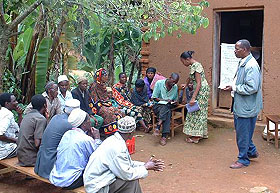 |
||||||||||||||||||||||||||||||
Tanzania
Usambara Mountains in the Eastern Arc Mountains chain Several Department of Research and Development (DRD) research institutes are active in this site: Selian Agriculture Research Institute (SARI) contributing agronomy, livestock, maize, banana, beans and socio-economics expertise; Hort Tengeru, vegetables; Lyamungu, coffee; and Mlingano National Soils Research Institute, soil fertility and conservation. Researchers also collaborate closely with district extension and community development departments, several NGOs, CIAT/TSBF and ALTERRA. The Lushoto landscape is punctuated with steep slopes, small valleys, erodible soils poor in N, P and K and a few, remnant forests. Mixed farming is widely practiced and farmers have relatively recently organized collective marketing of milk and vegetables. The two major thrusts of the research has been: sustainable intensification and diversification (new vegetable, banana, maize, bean, coffee varieties) which is now being followed up with local seed production; improving soil fertility and conservation through introduction of agroforestry and herbaceous fodder and legume species on boundaries and bunds; soil and water conservation structures and various options for improving soil fertility. Research on IPM has focused on bean pests and diseases as related to soil management. The dissemination thrust is looking at drama and seed systems and has found farmer exchange visits to be instrumental in getting farmers to change, socially and technically. A network of farmer research groups and sub-groups has emerged. They participate in research activities and are now undertaking some of their own projects. The research work will now be exploring other issues identified by communities:
|
||||||||||||||||||||||||||||||
